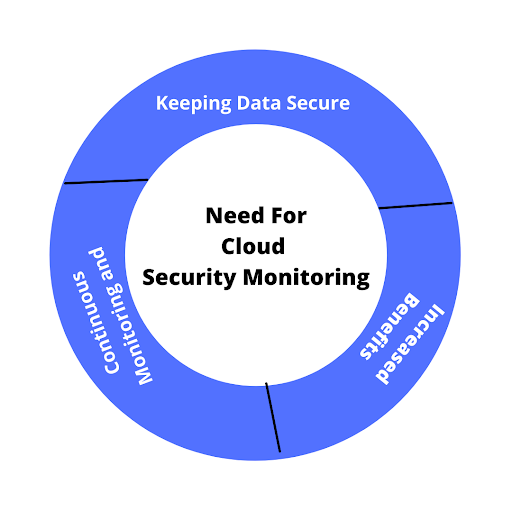What is Cloud Security Monitoring?
As the name already suggests, Cloud security monitoring is the process of protecting the data stored in the cloud from any unauthorized access.
When it comes to cloud security and management, monitoring the cloud infrastructure is one of the most critical components.
The whole concept of cloud security management revolves around the experts assessing the security tools and modules the organization has implemented. Further, helping the company to enhance their strength while reducing threats to their IT infrastructure.
Cloud monitoring includes both automated as well as manual assessment, which involves monitoring websites, servers, software platforms, and mobile apps. Moreover, for proper cloud security management, the solution has to reach all aspects of the cloud, including the cloud data sharing applications, cloud access management tools, and others.
What is the Need for Cloud Security Monitoring?
The criticality of monitoring in cloud security and management has grown from being a caution or threat detection to an essential aspect. This has increased the reliability of service providers on automated solutions for real-time assessment and measurement of data, applications, or infrastructure behaviors to identify potential security threats.
1. Keeping Data Secure:
Cloud security monitoring has increasingly facilitated the identification of patterns and high-risk vulnerabilities in an infrastructure. Additionally, the reluctance of companies to the adoption of cloud computing on the back of control-related uncertainties has been ebbing away, with the promise of effective security monitoring to make the data transfer and storage more convenient.
2. Continuous Monitoring & Securing:
Cloud monitoring helps to review online computing resources for workflow optimization while ensuring ceaseless service availability and high performance of servers, websites, and application security monitoring. It also aids in the evaluation of resource availability, program speed, and resource levels, to further help predict vulnerability attacks before their occurrence.
3. Increased Benefits
Companies adopting cloud monitoring have found a perfect balance between mitigating risks and leveraging the benefits of the cloud environments, without any hindrances to business processes.

Key Best Practices for Effective Cloud Security Monitoring
- Stringent Data Control
- Securing the Code
- Separating Crucial Metrics
- Patch Management
- Automation
- Identity and Access Management
- Data Protection
1. Stringent Data Control
One of the most efficacious measures for mitigating cloud security risks is gaining complete control over data across all endpoints. Using solutions that scan, assess and take action on the data sources, before its transition from an enterprise network, enables a robust defense against any data loss through the cloud provider.
This further helps in avoiding attack surface vulnerabilities, such as uploading of sensitive files to unprotected cloud repositories.
2. Securing the Code
Securing codes must be one of the top priorities, to eliminate risks from potential cyberthreats. During the development of codes for websites, the focus lies in selecting the right security development lifecycle (SDL), which aligns well with the delivery strategies of companies. Key benefits associated with secure SDL include continuous security, early risk detection, threat detection, improved stakeholder awareness, and reduction of business risks.
One of the four Secure Software Pillars is the Security Development Lifecycle. Further, in general, you can say that SDL is the process of incorporating security artifacts across the software development lifecycle.
SDL activities are mapped either using an agile or waterfall method. In addition, the Software Development Lifecycle has 7 phases, including:
- Concept
- Planning
- Design and development
- Testing
- Release
- Sustain
- Disposal
Please note, these phases can be modified according to the organization’s requirements or needs.
3. Separating Crucial Metrics
A software developer aims at learning features of cloud security monitoring while designing new software with specific security aspects. For the implementation of a monitoring strategy, key considerations must be emphasized such as
- Determination of the resource inventory utilized in the organization
- Mapping all attributes of data that the organization aims to gather
- Mutual decision appertaining to software that best suits the organization
While several cloud security monitoring solutions have been launched, the above guidelines would help in the successful execution of online monitoring system practices.
4. Patch Management
Unpatched software and system result in significant issues. Keeping an organization’s environment secure by updating the systems regularly has become imperative.
Key requirements for an organization to eliminate risks for their systems include asset inventory, vulnerability data gathered, and configuration for understanding the criticality of the risks associated. Organizations must consider preparing the checklist of important procedures and make sure to keep all updates in check for arresting the vulnerabilities before implementation into the live environment. An apt blend of vulnerability scanning and automatic patching allude lower impact of threats.
5. Automation
Scripting remains an essential feature in the cloud security monitoring strategy, as monitoring and reporting processes can be scripted for enabling automation of systems. Organizations must focus on the implementation of the monitoring software owing to the virtual nature of operations on the cloud environments, even as automating the red-flag and logging system for real-time alerts.
In simple terms, Cloud automation is the activity or discipline of automating part or all of the manual operations associated with managing and operating cloud-based IT infrastructure using specific software tools and methodologies.
The automation process generally has four steps, including:
- First, automate the infrastructure setup.
- Automate Script
- Automate Deployments
- Automate Security Monitoring
In addition, organizations must focus on implementing the monitoring software owing to the virtual nature of operations on the cloud environment, even automating the red-flag and logging system for real-time alerts.
Key benefits of Automation include reduced IT costs, continuous deployment, and others.
6. Identity and Access Management
Identity and access management provides capabilities of provisioning and access control for users. Administrators can use the IAM to manage users and groups and implement granular permission rules to limit access to resources and APIs.
Organizations must ensure the policies created are attached to roles or groups instead of individual users to deprive unnecessary or excessive privileges or permissions to users. To stem any unauthorized access to resources, organizations must provision access to these resources using roles instead of giving separate set of credentials for access.
It must be made sure that users are provided minimal access privileges to resources, which would not restrict them to fulfil their responsibilities. All users must have a multifactor authentication for their individual accounts as a defensive strategy against any compromised account.
Organizations must also limit the number of users with administrative privileges. The access keys must be rotated on a regular basis, and standardized periodically for password expiration, ensuring inaccessibility to data sources with a potential stolen or lost key.
A strong password policy must be enforced, requiring a minimum of fourteen characters that contain at least one symbol, one uppercase letter and one number. Also, a password reset policy must be enforced to prevent users from using the password used in the past 24 resets.
7. Data Protection
New technologies entail distinct issues and with the cloud-based storage solutions on the fore, data protection has become an imperative challenge to be addressed.
Organizations must opt for the cloud service providers that deliver data encryption as a standard feature in their offerings. Encrypting highly sensitive data including personally identifiable information (PII) or protected health information with the aid of customer-controlled keys has become a must-have for organizations eyeing the move to cloud computing. Customer-controlled key put the pressure of management on the customer, however they provide better control.
Organizations must choose the provider who guarantees protection against loss of critical data and meet the needs of data backup and recovery. Data replication is a common practice among the cloud service providers to ensure persistence. Organizations must thoroughly analyze the cloud deployment to identify where the replicated data has been cached or stored and take actions accordingly to ensure that the copied data has been deleted.
Choose Cloudlytics for Cloud Security Monitoring
Cloudlytics stands out as an exceptional cloud security monitoring solution, offering a comprehensive suite of features and capabilities that set it apart from the competition. With a user-friendly interface and robust functionality, Cloudlytics provides real-time visibility into your cloud infrastructure, enabling you to proactively detect and respond to security threats and vulnerabilities. Its advanced threat detection algorithms and machine learning models help safeguard your data and applications, ensuring compliance with industry regulations such as GDPR, HIPAA, and more.
Cloudlytics also excels in scalability, allowing your organization to grow without compromising security. With its regular updates and continuous improvement, Cloudlytics remains at the forefront of cloud security, making it the ideal choice for businesses and enterprises looking to protect their digital assets in the cloud. Trust in Cloudlytics for unmatched cloud security and peace of mind.
Cloud security monitoring is all about understanding vital business requirements, let alone being a mere platform debate. The importance of effective cloud security monitoring grows unabated, helping organizations in determining the type of data on which an employee is working, along with the exact location. Industries across the globe must adopt safety measures before things are out of their scope to resolve.
Further reading
- How Network Security is different from Cloud Security?
- The Need for Cloud Security Standards
- What is SaaS Security?
- An Ultimate Guide on Cloud-based Application Security Assessment
Monitor your business’ security in the cloud. Book a free demo now!

